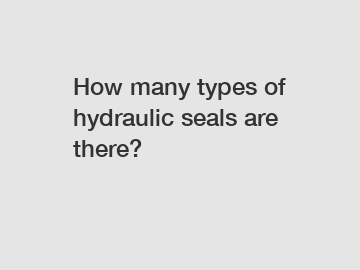Jan. 26, 2024
Mechanical Parts & Fabrication Services
King Seal supply professional and honest service.
How many types of hydraulic seals are there?
Hydraulic seals are critical components in fluid power systems, playing a crucial role in preventing leakage and maintaining the efficient operation of various hydraulic machinery. These seals are designed to withstand high pressure and ensure the smooth functioning of hydraulic systems. However, with numerous types of hydraulic seals available in the market, it can be challenging to understand which one is suitable for your specific application. In this article, we will explore the different types of hydraulic seals and their key characteristics, helping you make an informed choice.

1. Rod Seals.
Rod seals, also known as piston seals, are hydraulic seals specifically designed to prevent fluid leakage from the cylinder head while the rod is extending and retracting. These seals are typically made from materials like polyurethane, rubber, or PTFE and are fitted tightly around the rod, forming a barrier against pressurized fluid.
2. Piston Seals.
Piston seals, or cylinder seals, have a similar function to rod seals but operate on the inner diameter of the cylinder bore. They prevent fluid leakage from the opposite side of the rod seals during the piston's extension and retraction. Piston seals are commonly made from elastomer materials like nitrile rubber, polyurethane, or PTFE, providing high wear resistance and compatibility with hydraulic fluids.
3. Wiper Seals.
Wiper seals, also known as scraper seals, are used to remove contaminants such as dirt, dust, and moisture from the rod's surface. They prevent these contaminants from entering the hydraulic system and causing damage to other seals or components. Wiper seals are typically made from materials like polyurethane to ensure effective sealing and durability in harsh environments.
4. O-Rings.
O-rings are one of the most commonly used hydraulic seals due to their simplicity and versatility. These seals are circular elastomer rings with a round cross-section, designed to fit into a groove and create a tight seal. O-rings can be used in various hydraulic components, including cylinders, valves, and fittings. They are available in different materials such as nitrile rubber, Viton, or silicone, offering compatibility with a wide range of fluids and temperatures.
5. Buffer Seals.
Buffer seals are hydraulic seals used in double-acting cylinders to prevent metal-to-metal contact between the piston and cylinder head. These seals are usually made from polyurethane or rubber and are installed on the dynamic side of the piston. Buffer seals absorb pressure spikes and ensure smooth cylinder operation by separating the primary rod or piston seal from excessive hydraulic fluid pressure.
In conclusion, hydraulic systems rely on various types of seals to ensure efficient and leak-free operation. Choosing the right seal depends on factors such as application requirements, fluid compatibility, pressure conditions, and environmental conditions. Understanding the different types of hydraulic seals and their unique characteristics can help you select the most suitable seal for your specific needs.
If you need further assistance or have any questions regarding hydraulic seals or any other fluid power components, feel free to contact us. We have a team of experts who can provide guidance and support in selecting the right hydraulic seal for your application.
If you are looking for more details, kindly visit Floating Seal.
If you are interested in sending in a Guest Blogger Submission,welcome to write for us!
All Comments ( 0 )